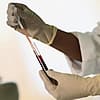
What's Hot
What's Hot
| News flashes are posted here frequently to keep you up-to-date with the latest advances in health and longevity. We have an unparalleled track record of breaking stories about life extension advances.
Healthy habits improve quality of life of cancer survivors
Kevin Stein PhD and colleagues analyzed data from over 9,000 participants in the American Cancer Society's Study of Cancer Survivors-II (SCS II), which examined health related quality of life among survivors identified through American cancer registries. Although the majority of these cancer survivors were nonsmokers, the analysis showed that 80 to 85.2 percent of the participants failed to meet the 5-A-Day recommended intake of fruit and vegetables, and 52.7 to 70.4 were not meeting recommended physical activity levels. Only 5 percent of the subjects practiced all three healthy lifestyle behaviors. Participants who engaged in any of the three healthy practices were found to have a better quality of life than those who did not. Maintaining adequate exercise was related to the greatest increase in quality of life scores. “It is concerning that up to 12.5 percent of cancer survivors are not meeting any lifestyle behavior recommendation and less than 10 percent on average across the cancer groups are meeting two or more recommendations,” Dr. Stein stated. “What is particularly noteworthy is that following lifestyle behavior recommendations not only can have a positive impact on physical health outcomes, but also have the added benefit of having a positive impact on quality of life. We also found that the relationship between compliance with recommendations and quality of life is cumulative. That is, that the more recommended health behaviors survivors engage in (e.g. eating better, being active, not smoking), the more powerful the impact on their quality of life.” —D Dye Vitamin supplements inhibit tuberculosis recurrence
Edward Villamor, MD, DrPH, of the Harvard School of Public Health and his associates enrolled 887 patients being treated for pulmonary TB for the current study, of whom 471 were also infected with HIV that was not being treated with antiretroviral drugs. The participants received a daily regimen consisting of a placebo or 5000 international units vitamin A, 20 milligrams vitamin B1, 20 milligrams vitamin B2, 25 milligrams vitamin B6, 100 milligrams niacin, 50 micrograms vitamin B12, 500 milligrams vitamin C, 200 milligrams vitamin E, 0.8 milligram folic acid, and 100 micrograms selenium, for an average of 43 months. Among participants whose TB cultures became negative one month after beginning drug treatment, those who received the supplements had a 45 percent lower rate of TB recurrence compared with the placebo group, as well as a reduced incidence of peripheral neuropathy, which is a side effect of tuberculosis drug treatment. This decrease in recurrence was greater among supplemented participants who were HIV positive, who experienced a 63 percent reduction. In HIV negative subjects who received the nutritional supplements, and CD3 and CD4 immune cells were increased and deaths were marginally reduced. "We found that providing micronutrients to patients with tuberculosis who were undergoing anti-TB treatment appeared to decrease the risk of recurrences," Dr Villamor stated. "This effect was stronger in patients infected with HIV than in those who were HIV-negative. This could be relevant because TB reactivation is common among HIV-infected persons." He added, "It will be important to find out whether micronutrients improve the outcome of TB treatment in TB-HIV co-infected patients who are undergoing antiretroviral therapy." —D Dye Germ-line stem cell removal lengthens life
“We wanted to see if Kenyon’s findings could be duplicated in the fly,” lead researcher Marc Tatar, PhD explained. “If so, we’d know that reproductive control of lifespan was a general principle in biology.” Professor Tatar and colleagues activated a gene that controls the flies' germ-line precursor cells, resulting in their elimination. These insects survived 20 to 50 percent longer than normal flies. The researchers found that the sterile flies responded less to insulin, which can be a life-shortening hormone, while paradoxically making more of it. They discovered that the flies' reproductive organs manufacture a protein which binds to insulin, blocking its signals. “This suggests that the gonad and the brain are in a synchronized hormonal feedback loop,” Dr Tatar stated. “It’s not just the brain affecting the gonad, but also the other way around.” “We think that in mammals, a similar communication occurs between the brain and the gonad, communication which controls insulin signaling,” added first author Thomas Flatt. “And when insulin signaling is reduced, the body goes into a state of high repair. The body becomes more stress resistant. Tissues protect themselves really well – and that increases longevity.” He concluded, “Our research suggests that signals from the reproductive system can regulate aging in animals – including, possibly, humans.” —D Dye Review points to need for vitamin D supplementation for optimal brain function
Dr Bruce N. Ames, who is a senior scientist at Children’s Hospital Oakland Research Institute, and assistant staff scientist Joyce C. McCann, PhD observe that the wide distribution of vitamin D receptors in the brain provide evidence for the vitamin's involvement in the function of that organ. They note that the vitamin has the ability to affect brain proteins involved with motor control, learning and memory, and possibly social and maternal behavior. Additionally, findings from clinical and laboratory studies suggest that vitamin D inadequacy might have cognitive and behavioral consequences. Because vitamin D is found in few foods, and since many individuals are unable to adequately form vitamin D in their skin due to darker pigmentation, Drs McCann and Ames conclude that supplementation is warranted for populations whose whose vitamin D status is low. “This critical analysis of vitamin D function and the brain is a model of careful thinking about nutrition and behavior”, FASEB Journal Editor in Chief Gerald Weissmann stated. “One wishes that all studies of nutritional supplements or requirements were this thoughtful. Drs. McCann and Ames deftly show that while vitamin D has an important role in the development and function of the brain, its exact effects on behavior remain unclear. Pointing to the need for further study, the authors argue for vitamin D supplementation in groups at risk.” —D Dye Calorie restriction may help reduce the risk of carcinoma
University of Texas M.D. Anderson's Science Park Research Division Director John DiGiovanni, PhD and his colleagues gave mice a control diet, diets providing 15 or 30 percent percent fewer calories than the control diet, or an obesity-inducing diet which derived 60 percent of its calories from fat. The animals then received agents that induced premalignant lesions called papillomas. Mice that received the restricted diets were found to have fewer papillomas than animals that consumed the control and high fat diets. In a separate experiment, dietary energy balance (the relationship between the intake of calories and their expenditure) was determined to effect the development of carcinoma through its influence on the amount of premalignant lesions that develop rather than on their conversion to malignancy. "Calorie restriction and obesity directly affect activation of the cell surface receptors epidermal growth factor and insulin-like growth factor," explained study coauthor Tricia Moore, who is a graduate student in M. D. Anderson's Department of Carcinogenesis. "These receptors then affect signaling in downstream molecular pathways such as Akt and mTOR. Calorie restriction, which we refer to as negative energy balance, inhibits this signaling, and obesity, or positive energy balance, enhances signaling through these pathways, leading to cell growth, proliferation and survival." "These results, while tested in a mouse model of skin cancer, are broadly applicable to epithelial cancers in other tissues," Dr DiGiovanni stated. "These findings provide the basis for future translational studies targeting Akt/mTOR pathways through combinations of lifestyle and pharmacologic approaches to prevent and control obesity-related epithelial cancers in humans." —D Dye Higher vitamin D levels associated with peripheral artery disease protection
The researchers used data from a national survey which measured blood levels of vitamin D in 4,839 adults. Participants were tested for PAD using the ankle-brachial index, which measures blood flow to the legs. Those whose vitamin levels were lowest, at less than 17.8 nanograms per milliliter, had a 8.1 percent incidence of PAD, while only 3.7 percent of those with the highest levels of over 29.2 nanograms per milliliter had the disease. Adjusted analysis of the data determined a 64 percent increased risk of peripheral artery disease among participants whose vitamin D levels were lowest compared with those whose levels were highest, and a 29 percent increase in PAD risk with each decline of each 10 nanograms per milliliter decline in the vitamin. “We know that in mice, vitamin D regulates one of the hormone systems that affects blood pressure,” stated Dr. Melamed, who is an assistant professor at Yeshiva University's Albert Einstein College of Medicine. “Since cells in the blood vessels have receptors for vitamin D, it may directly affect the vessels, although this has not been fully worked out.” Dr Melamed added that high levels of vitamin D could be a marker for other healthy lifestyle factors, and that confirmation of a cause and effect relationship between the vitamin and diminished PAD risk will necessitate a clinical trial involving vitamin D supplementation. —D Dye Calorie restriction prevents, obesity promotes precancerous pancreatic lesions
Stephen D. Hursting, PhD, who is a professor in M. D. Anderson's Department of Carcinogenesis, and his colleagues compared the effects of a calorie restricted diet, an overweight-inducing diet, and an obesity-inducing diet on a strain of mice that spontaneously develop precancerous pancreatic lesions associated with pancreatitis. While 57.5 percent of the animals on the obesity-inducing diet and 45 percent on the overweight diet developed pancreatic lesions, a restricted diet was associated with the development of lesions in just 7.5 percent of the animals, and the lesions were not large enough to produce symptoms. Additionally, mice that were given calorie restricted diets had lower levels of inflammation signaling proteins as well as insulin-like growth factor-1 (IGF-1), which stimulates the growth of a variety of cancer cell types. "Mice on the heavier diets had significantly more lesions and larger lesions than those on the restricted calorie diet," observed study coauthor Laura Lashinger, PhD, who is a postdoctoral fellow in Dr Hursing's laboratory. She added that the decline in inflammatory proteins among the restricted mice is explained by the fact that fat tissue is a major source of inflammatory factors. "Obesity is a known risk factor for pancreatic cancer, but the mechanism underlying that relationship is unknown," Dr Hursing commented. "Our findings indicate that calorie restriction hinders development of pancreatic cancer, which could have implications for prevention and treatment of pancreatic tumors caused by chronic inflammation and obesity." —D Dye Remember to eat more blueberries
Dr Jeremy Spencer at the University of Reading in England and and his colleagues gave 8 aged rats a diet supplemented with powdered blueberries for 12 weeks, while 8 aged and 8 young rats received unenhanced diets. Tests of spatial working memory were conducted before the treatment period and every three weeks thereafter for the duration of the study. The animals' brains were examined for levels of flavonols and anthocyanins, which are flavonoids contained in blueberries, at the study's conclusion. Flavonoids that were found to be elevated in the cortex and hippocampus of the brains of blueberry fed animals were not detected in the blood or brains of animals that received the standard diets. On the spatial memory tests, young rats performed significantly better than both groups of aged animals, yet after only three weeks of blueberry supplementation, aged rats improved their memory test scores from a 60 percent accuracy score to 83 percent. This increase was maintained until the end of the study. Analysis of decision making time also noted improvement among rats that received blueberries. The researchers demonstrated that blueberry flavonoids improve memory by activating signaling proteins in a pathway in the brain's hippocampus, which controls learning and recall. “"This study not only adds science to the claim that eating blueberries are good for you, it also provides support to a diet-based approach that could potentially be used to increase memory capacity and performance in the future," noted study coauthor Dr Matt Whiteman. "Indeed, Dr. Spencer’s research team plan on extending these findings further by investigating the effects of diets rich in flavonoids on individuals suffering from cognitive impairment and Alzheimer’s disease.” —D Dye Tea with lemon not a bad idea
For the current research, Dr Orozco, who is a graduate student in the laboratory of Dr Joshua Bomser, and his colleagues at Ohio State and Perdue University utilized a model that simulates digestion in the stomach and small intestine. Stomach and colon cancer cells were treated with undigested and digested extracts of green or black tea, or a combination of tea catechins epigallocatechin gallate (EGCG) and epigallocatechin (EGC). The team found that digestion of green tea and catechins significantly reduced their anticancer activity, while the activity of black tea remained the same. Additionally, the undigested extracts were found to be twice as effective in colon cancer cells than in stomach cancer cells. Previous research conducted by Dr Ferruzzi had determined that the addition of citrus or vitamin C to green tea protected tea catechins from degrading during digestion. Adding lemon juice resulted in 80 percent of tea catechins remaining available for absorption. Dr Bomser noted that understanding the impact of digestion on tea could lead to changes in product formulation in order to protect the plant's cancer fighting properties. The study's findings are also likely to apply to other active compounds in foods. The association of drinking green tea with numerous health benefits despite the instability of identified compounds may indicate that other compounds contribute in part to its effects. Further research will be necessary to identify these compounds and determine the effect of digestion on their activities. —D Dye Fasting protects healthy cells from chemotherapy effects
Dr Longo's team first tested their hypothesis using six different rat and human cancer cell lines as well as normal cells, and found that low glucose or a low-serum media protected the healthy cells against the drug cyclophosphamide while leaving cancer cells vulnerable. In a subsequent experiment in mice injected with aggressive human cancer cells, those that underwent a two day fast prior to receiving a high dose of the drug etoposide continued to thrive, while among mice fed normally, the 50 percent who survived experienced lasting weight and energy loss. “This is a very important paper," stated cancer researcher professor Pinchas Cohen of the University of California, Los Angeles. "It defines a novel concept in cancer biology. In theory, it opens up new treatment approaches that will allow higher doses of chemotherapy. It’s a direction that’s worth pursuing in clinical trials in humans.” “It was almost like an idea that was not even worth pursuing. In fact it had to come from the anti-aging field, because that’s what we focus on: protecting all cells at once,” Dr Longo said. “Now we need to spend a lot of time talking to clinical oncologists to decide how to best proceed in the human studies.” “It is the sort of opposite of the magic bullet," UCLA research professor of chemistry Edith Gralla observed. "It’s the magic shield.” —D Dye Citrus flavonoid naringenin inhibits hepatitis C
Harvard Medical School research fellow Yaakov Nahmias, PhD and colleagues first described their discovery that HCV is secreted by infected cells while bound to very low density lipoprotein (vLDL), and that silencing apolipoprotein B (the primary apolipoprotein in LDL) messenger RNA in infected cells results in a 70 percent reduction in the secretion of the virus that is necessary to maintain chronic infection. Naringin, which is commonly found in citrus fruits, is metabolized by the body's intestinal bacteria to naringenin, which, in addition to its antioxidant activity, has been shown to reduce plasma cholesterol levels. Acting on previous findings which showed that naringenin inhibited vLDL secretion from the liver, the researchers cultured HCV infected human cells with the flavonoid for 24 hours. They found that naringenin inhibited HCV secretion dose-dependently and without toxicity, with an 80 percent reduction occurring at the highest concentration tested. "The ability of the liver to regenerate in the context of the RNA-based lifecycle of HCV allows for the potential clearance of the viral infection," the authors write. "It is thought that clearance occurs in about 30% of HCV infected patients. The possible reduction of HCV viral load by inhibiting viral secretion could allow uninfected cells to regenerate, potentially increasing the overall rate of viral clearance." They suggest that future studies concentrate on naringenin or other flavonoids' long term ability to reduce viral load in animal models as well as human liver cell cultures. —D Dye |

 An article published in the May, 2008 issue of the
An article published in the May, 2008 issue of the  An article scheduled to appear in the June 1, 2008 issue of
An article scheduled to appear in the June 1, 2008 issue of  Elimination of the cells that create eggs and sperm, known as germ-line stem cells, produces a longer life span--that is, if you're a fruit fly. In a report published online on April 23, 2008 in the
Elimination of the cells that create eggs and sperm, known as germ-line stem cells, produces a longer life span--that is, if you're a fruit fly. In a report published online on April 23, 2008 in the  A review published online on April 22, 2008 in the
A review published online on April 22, 2008 in the  A presentation on April 14, 2008 at the American Association for Cancer Research annual meeting revealed that
A presentation on April 14, 2008 at the American Association for Cancer Research annual meeting revealed that  At the American Heart Association’s Arteriosclerosis, Thrombosis and Vascular Biology Annual Conference 2008, Dr Michal Melamed of Yeshiva University reported the finding that increased blood levels of vitamin D are related to a lower risk of peripheral artery disease (PAD). Peripheral artery disease occurs when the legs' arteries become narrowed by
At the American Heart Association’s Arteriosclerosis, Thrombosis and Vascular Biology Annual Conference 2008, Dr Michal Melamed of Yeshiva University reported the finding that increased blood levels of vitamin D are related to a lower risk of peripheral artery disease (PAD). Peripheral artery disease occurs when the legs' arteries become narrowed by  The annual meeting of the American Association for Cancer Research was the site of a presentation by investigators from the University of Texas at Austin and the University of Texas M. D. Anderson Cancer Center of their research findings which suggest that calorie restriction may help prevent
The annual meeting of the American Association for Cancer Research was the site of a presentation by investigators from the University of Texas at Austin and the University of Texas M. D. Anderson Cancer Center of their research findings which suggest that calorie restriction may help prevent  An article scheduled for publication in the journal
An article scheduled for publication in the journal  On April 7, 2008 at the at Experimental Biology 2008 conference in San Diego, Fabiola Gutierrez Orozco of Ohio State University presented the finding that digestion significantly modifies tea catechins and their anticancer property, and that adding citrus or ascorbic acid (vitamin C) can prevent much of this from occurring.
On April 7, 2008 at the at Experimental Biology 2008 conference in San Diego, Fabiola Gutierrez Orozco of Ohio State University presented the finding that digestion significantly modifies tea catechins and their anticancer property, and that adding citrus or ascorbic acid (vitamin C) can prevent much of this from occurring. In what has been called a one of a kind study, Valter D. Longo of the University of Southern California Andrus Gerontology Center and his colleagues report that "short term starvation" (fasting) protects healthy cells and whole animals from the adverse effects of high dose chemotherapeutic drugs, while leaving cancer cells vulnerable to the drugs' destructive properties. The research was published online on March 31, 2008 in the journal
In what has been called a one of a kind study, Valter D. Longo of the University of Southern California Andrus Gerontology Center and his colleagues report that "short term starvation" (fasting) protects healthy cells and whole animals from the adverse effects of high dose chemotherapeutic drugs, while leaving cancer cells vulnerable to the drugs' destructive properties. The research was published online on March 31, 2008 in the journal  An article published online on January 7, 2008 in the journal
An article published online on January 7, 2008 in the journal 